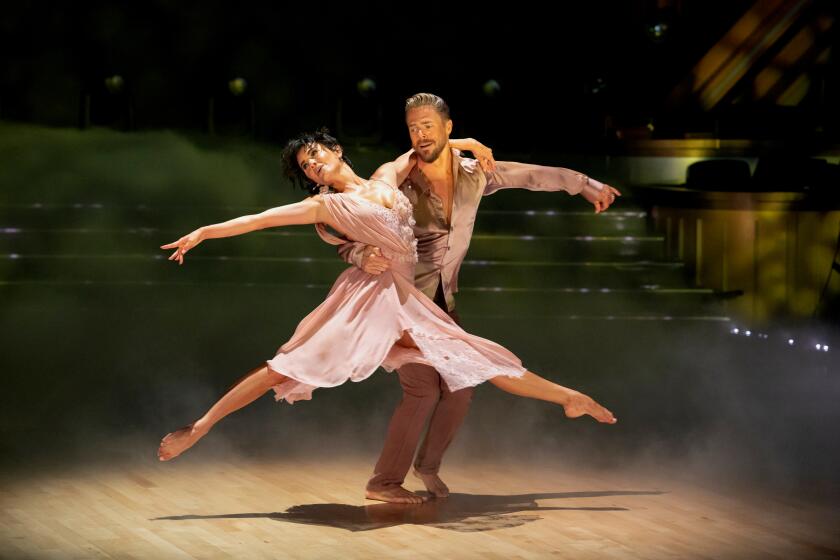An Education for the Living and the Dead
SAN FRANCISCO â The Deadheads returned to Davies Symphony Hall on Sunday. And they returned, this time, on the promise of actually hearing the surviving members of the Grateful Dead.
On Friday and Saturday nights, the Deadheads in attendance had been the talk of the opening of the San Francisco Symphonyâs American Festival, since the band itself, which appeared in John Cageâs âRenga,â was a practically inaudible part of a vast sonic mix.
But for a marathon program titled âAn Afternoon With Americaâs Visionaries,â the Dead members were scheduled to perform a new piece of their own, â âSpaceâ for Henry Cowell,â with Michael Tilson Thomas jamming at the keyboard.
And at the end of a nearly four-hour concert, they did get to hear a 12-minute group improvisation, the report of which will surely make every orchestra management in the country turn green with envy. There they were, four of pop musicâs legends--percussionist Mickey Hart, bass player Phil Lesh, guitarist Bob Weir and keyboardist Vince Welnick--grooving with the music director of the symphony.
Tilson Thomas played a MIDI piano with great and credible panache, and the Dead responded to him with ardor. Overjoyed Deadheads danced ecstatically at their seats, and there were wide grins on the faces of nearly all in the very mixed audience as well.
*
History was made. But not because of the memorable improvisation. That was the show business part of the afternoon (great show business though it was). What came before was the creation of a context, and that was brilliant. Tilson Thomas gave the Deadheads not just 12 minutes of ecstasy; he also gave them an education.
Tilson Thomas fashioned a program that featured music from what he called the American maverick tradition, and he invited the 79-year-old patriarch of West Coast music, the composer Lou Harrison, to be co-host. Looking like the Santa Claus of new music (as Tilson Thomas likes to call him), with his snowy beard and trademark billowing red shirt, Harrison introduced most of the music in a genial personal manner that alerted the ears. Funny, elegant, idiosyncratic and surprising, he simply told us why he liked what we were about to hear.
The program revolved around the early experimental music of Henry Cowell, who had been Harrisonâs teacher, and the West Coast contribution to new music, although there were a few outsiders invited in to demonstrate that the Californians were not an isolated phenomenon.
Much of the music was percussion, or âdrums along the Pacific,â as Harrison quipped. Tilson Thomas conducted a bakerâs dozen of percussionists in Vareseâs groundbreaking âIonization,â and he also led three movements from Harrisonâs alluringly melodic and thunderous Concerto for Organ and Percussion, with John Walker as the gallant soloist. Steve Reich was invited to perform his âClapping Music,â a famous piece in which the composer and percussionist Raymond Froehlich clapped cycles of rhythmic phases.
*
Also on hand was Meredith Monk, who sang excerpts of a number of works and offered a new piece, âNew York Requiem,â a magnificent welling up of emotion from textless song meant to sustain hearts made heavy by AIDS. In Ben Johnstonâs arrangement, for singer and string quartet, of Harry Partchâs âBarstow Songs,â Johnston and the Kronos Quartet uncannily recreated Partchâs hobo-text inflections and the sounds of his strange instruments.
Kronos brought in Terry Riley, the original Minimalist, with a movement from his âSalome Dances for Peaceâ; and the Abel-Steinberg-Winant Trio included the Second Sonata for Violin with piano and drums by George Antheil (a wild man, Harrison called him) from the composerâs bad-boy Paris years in the â20s, not his later, more sanguine period as a Hollywood composer.
But all of this was seen in the light of what Cowell first did, in the Bay Area in the teens and â20s--his bashing his palms and elbows on the piano, his playing inside the piano directly on the strings, his employment of the Asian music he heard around San Francisco, his performing on found instruments, his love for percussion.
Cowell did it all first. And there were marvelous performances of his piano pieces by Julie Steinberg, of the short but pungent âQuartet Euphometricâ by Kronos, of the multicultural âSet of Fiveâ by the Abel-Steinberg-Winant Trio, and the percussion masterpiece âOstinato Pianissimoâ by members of the SFS Youth Orchestra, conducted by Alasdair Neale.
And suddenly one started to sense mental lightbulbs switching on, and this is what every orchestra in America would like to accomplish. Those experiments in sonics that the Dead explored at the beginning of their number had precedents, and when MTT (heâs no Tilson Thomas when he rocks) and the Dead improvised on Cowell tunes, the tunes sounded like Dead riffs. It is very possible that many people learned that afternoon that the music of our time and place--all kinds of it--is the way it is because we are the way we are.
After the concert, a German music critic observed that this, not its traditional programs, is what the San Francisco Symphony should bring to Europe when it tours. âWe need to be shown,â he said, âthat we did not invent everything.â
* The San Francisco Symphonyâs American Festival, through June 29 at Davies Symphony Hal. Information: (415) 864-6000.
More to Read
The biggest entertainment stories
Get our big stories about Hollywood, film, television, music, arts, culture and more right in your inbox as soon as they publish.
You may occasionally receive promotional content from the Los Angeles Times.











